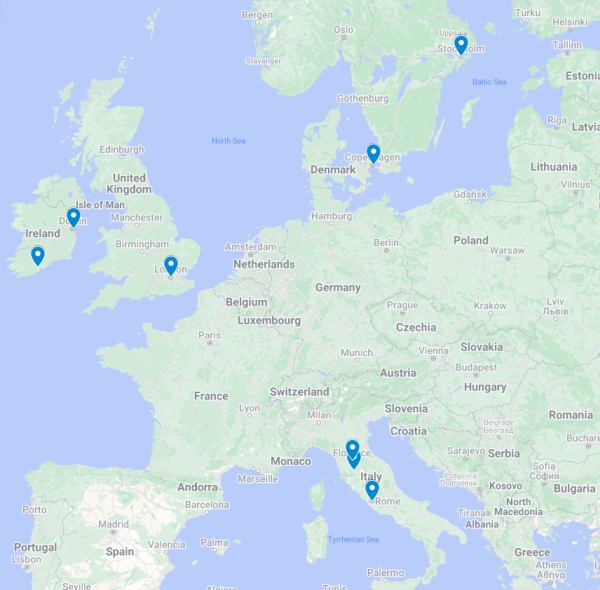Global Crossroads aims to develop internationalization
Allegheny College faculty and staff came together in 2010 to decide on how to improve the institution with a strategic plan called Combinations 2020. According to the plan, global and local diversity needed to be addressed. Part of this involved the improvement of the internationalization of Allegheny’s campus and curriculum. The plan set out to attract more international students and a required study away program for all students.
According to Terry Bensel, professor of environmental science and director of the Allegheny Gateway, the intention to improve numbers and require study away has fallen short. Allegheny College is on the low end of the Greater Lakes Colleges Association schools in number of international students. The GLCA is a network of 13 schools around the Great Lakes area that work together to improve liberal arts education.
“I do think we’re positioned now in a better place than maybe we were five or six years ago to grow the number of international students,” said Bensel. “A lot of colleges focus on the numbers, but if those international students are not coming in and are not having the best experience possible, then I don’t think that’s internationalization.”
In an effort to boost internationalization within colleges, a proposal for $5.75 million was granted through the Andrew W. Mellon Foundation to all schools within the GLCA in August 2015. Allegheny College is the newest member of the GLCA and along with the 12 other schools, will be the beneficiaries of the new grant.
Bensel said that the grant was accepted with the intention that all GLCA schools will collaborate together. An example of this collaboration could be the introduction of Experiential Learning Seminars that involve participants from other GLCA schools.
The Global Crossroads program, a four-year collection of new programs intended to enhance the internationalization of the core departments in schools, was born out of this Mellon grant.
Global Crossroads is a collection of eight new initiatives and ideas for new opportunities for students and staff. It is broken down into programs for campuses, programs for faculty and additional programs within Global Crossroads.
Within the opportunities for programs on campus, the first and the most important program is the International Innovation Fund according to Bensel, who is also the Allegheny College liaison to the Global Crossroads program. This fund takes nearly half of the $5.75 million grant and splits it between the 13 GLCA schools.
From this, Allegheny will be able to apply for up to $180,000 to advance its goals to internationalize the education that defines each undergraduate’s experience of the liberal arts.
“You’ll see signs of that this time next year on Allegheny’s campus,” said Bensel. “This stuff doesn’t happen overnight.”
The other campus initiative is the Grand Challenge, which according to the GLCA website, is a portion of Global Crossroads that seeks to internationalize the entirety of the educational experience through a collaborative exploration of a significant issue. An institution within the GLCA will collaborate on research with any number of other institutions to create a set of shareable materials that present the results of their shared work.
The 2016-17 Grand Challenge topic is Challenging Borders. This is meant to include a wide range of issues for students and faculty to choose from at their discretion. From there, the issues can be narrowed to ideas such as political, economic and social borders.
Global Crossroads will also provide opportunities specifically for faculty. The Global Crossroads program includes an initiative of themed courses, or shared courses. This can allow for professors at two or more institutions within the GLCA to co-develop a course around a shared international theme regardless of the discipline. This means that an economics course at one institution may collaborate with a biology course at other institutions around a shared international idea.
This could even extend oversees to Global Liberal Arts Alliance schools, which are partnered with the GLCA. There could be programming, events or courses that may take place within all 16 GLAA schools and 13 GLCA schools.
“I think I’m more excited about the GLAA,” said Barbara Riess, chair of the modern and classical languages department. “I think that would be more exciting for us as language teachers to collaborate with people who are teaching a foreign language to other people who don’t speak English.”
Other additional initiatives have resulted from the Global Crossroads, including the Global Scholar program. The Global Scholar program allows a student to explore a significant international issue through co-curricular programing with that student’s home campus and two GLAA campuses in different parts of the world.
According to Bensel, schools have the option to partake in each of the eight programs. This means that Allegheny does not have to accept all eight programs to still partake in Global Crossroads.
This Mellon grant has already opened up new opportunities for Allegheny students and staff to seek educational opportunities abroad. For example, due to a separate Mellon grant, 10 to 15 staff and faculty participated in a study trip to Cuba over this last winter break, and they plan to present their experience to the community on Gator Day.
Another EL Seminar trip to Cuba will be proposed by Riess and Brittany Davis, professor of environmental science, for May 2017. This EL seminar is the result of the success of the staff and faculty trip over winter break along with the way that the Global Crossroads Program is coming together.
“We are thinking about using the Global Crossroads program to see if there’s anyone out there in the GLCA who gives environmental science or environmentally themed courses in Spanish for us to work with and perhaps develop a different unit based on our interests,” Riess said.
This will be the first time that Allegheny College will be sending students to Cuba since 2003. While recreational visits to Cuba are not allowed, since December 2014, the categories for which a traveler can apply to visit Cuba have broadened. This is what allows Allegheny to visit Cuba on a cultural education experience, according to Riess.
Even before the Global Crossroads program, Allegheny was using traditional ways to help promote internationalization such as the EL Seminars and study abroad programs.
“Honestly, Allegheny College makes it pretty easy to study abroad in a semester program,” said Shannan Mattiace, co-chair of the Study Abroad and Campus Internationalization Committee. “We’re one of the few colleges, even in the GLCA, that allow our students to take their aid and their scholarships with them. That’s very uncommon. I don’t think Allegheny students know how uncommon that is.”
Allegheny also promotes internationalization in other innovative ways. One way they have done this is through the incorporation of short courses into the curriculum. For example, a one-credit course in 2012 was given with Soren Hermanson, a wind energy expert from Denmark who came to Allegheny and taught 28 students for one week. Close to 10 of these classes have occurred since 2011.
“That’s a good example of internationalization,” said Bensel. “It’s an innovative way to bring more international perspectives and knowledge campus.”
Other examples of Allegheny’s internationalization prior to Global Crossroads include an international internship opportunity as an alternative way to get domestic students abroad instead of the traditional EL Seminars and study abroad programs.







